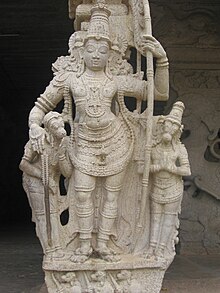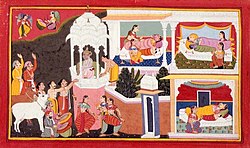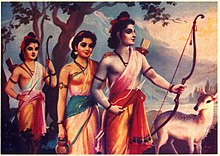Lakshmana
| Lakshmana | |
|---|---|
 Statue of Lakshmana at Srivaikuntanathan Perumal temple | |
| Affiliation | Avatar of Shesha |
| Abode | Ayodhya, Vaikuntha, Kshira Sagara |
| Weapon | Bow and Arrow, Dagger |
| Personal information | |
| Born | |
| Died | Sarayu river, Ayodhya |
| Parents | Dasharatha (father) Sumitra (mother) Kausalya (step-mother) Kaikeyi (step-mother) |
| Siblings | Shatrughna (brother) Rama (half-brother) Bharata (half-brother) Shanta (half-sister) |
| Spouse | Urmila |
| Children | Angada Chandraketu[1] |
| Dynasty | Raghuvaṃśa-Suryavaṃśa |
Lakshmana (Sanskrit: लक्ष्मण, lit. 'the fortunate one', IAST: Lakṣmaṇa), also known as Laxmana, Saumitra and Ramanuja, he is the younger brother of Rama and his loyalist in the Hindu epic Ramayana. Lakshmana is considered as an incarnation of Shesha, the lord of the Serpents and is the husband of Urmila, an avatāra of Nagalakshmi.[2][3]
Etymology
The name Lakshmana is of Sanskrit origin, which means 'the fortunate one'. He bears the epithets of Saumitra (Sanskrit: सौमित्र, lit. 'son of Sumitra', IAST: Saumitra) and Ramanuja (Sanskrit: रामानुज, lit. 'younger brother of Rama', IAST: Rāmānuja).[4]
Legend
Birth

King Dasharatha of Ayodhya had three wives: Kausalya, Kaikeyi, and Sumitra. He performed a yajna to beget sons and as a result, his queens became pregnant.[5] Lakshmana and his brother Shatrughna were born to Sumitra, while Rama and Bharata were born to Kausalya and Kaikeyi.[6]
In the Puranas, Lakshmana is described as an incarnation of Shesha,[7] the multiple-headed naga (serpent) upon whom rests the preserver deity Vishnu, whose avatar Rama is considered to be.[8][9] When sage Vishvamitra asked Rama to kill the demons in the forest, Lakshmana accompanied them and went to Mithila with them. Vishvamitra gives them the knowledge of the Devastras or celestial weaponry [bala and ati bala], trains them in advanced religion and guides them to kill powerful demons like Tadaka, Maricha and Subahu.[10]
Marriage

After Rama won the svayamvara of Sita, their marriage was fixed. King Dasharatha arrived in Mithila for his son's wedding and noticed that Lakshmana had feelings for Urmila, but according to tradition, Bharata and Mandavi were to marry first.[11][12] King Dasharatha then arranged for Bharata to marry Mandavi and Shatrughna to marry Shrutakirti, allowing Lakshmana to marry Urmila. Ultimately, all four sisters married the four brothers, strengthening the alliance between the two kingdoms.[13] The wedding ceremony was conducted under the guidance of Shatananda. During the homeward journey to Ayodhya, another avatar of Vishnu, Parashurama, challenged Rama to combat, on the condition that he was able to string the bow of Vishnu, Sharanga. When Rama obliged him with success, Parashurama acknowledged the former to be a form of Vishnu and departed to perform penance at the mountain Mahendra. The wedding entourage then reached Ayodhya, entering the city amid great fanfare.[14][15]
Urmila and Lakshmana had two sons named Angada and Chandraketu. Their elder son Angada, founded the kingdom of Karupada and the younger son founded the city of Chandrakanti in the Malwa country.[16]
Exile and war
Lakshmana served Rama and Sita reverently during the exile. In Panchavati, Lakshmana also built a hut for Rama and Sita to live in. Lakshmana cut off Ravana's sister Surpanakha's nose in anger when she tried to seduce Rama and insulted Sita. He played an important role in the war with Ravana and slew Ravana's sons Indrajita and Atikaya.[17]
On the first night of exile, when Rama and Sita were sleeping, the deity Nidra appeared before Lakshmana and he requested her to offer him the boon of not sleeping for the fourteen years.[18] The goddess asked him that she could grant his wish, but someone else would have to take his place asleep. Lakshmana asked the goddess to enquire his wife Urmila regarding this, who happily accepted the task. Urmila slept continuously for the fourteen years of exile, to complete the sleep of her and her husband's share. Urmila is notable for this unparalleled sacrifice, which is called Urmila Nidra.[19][20]

When Sita asked Rama to fetch a magical golden deer for her, Rama asked Lakshmana to stand guard as he sensed danger and evil. The golden deer was the demon Maricha, who distracted Rama. When Rama killed Maricha, he cried out in Rama's voice for help. Although Lakshmana knew that Rama was invincible and beyond any danger, Sita panicked and frantically ordered Lakshmana to go to Rama's aid immediately. Unable to disobey Sita, Lakshmana drew a perimeter line (Lakshmana Rekha), which Sita must not cross and went in search of Rama. Sita, however, out of compulsion of religious duty and compassion for Ravana, who was disguised as a poor Brahmin, crossed the line to give him alms, following which she was abducted.[21]
Through their search for Sita, Rama and Lakshmana meet Hanuman a, the biggest devotee of Rama, greatest of ape heroes, and an adherent of Sugriva. Rama befriends Sugriva and helps him by killing his elder brother Vali thus regaining the kingdom of Kiṣkindha, in exchange for helping Rāma to recover Sita. However, Sugriva soon forgets his promise and this enrage Lakshmana, who was ready to destroy the ape citadel.[22]
During the war between Rama and Ravana, Meghanada hurls a powerful weapon at Lakshmana and he gets mortally wounded. So Hanumana assumes his gigantic form and flies from Lanka to the Himalayas. Upon reaching Mount Sanjeevani, Hanumana is unable to identify the herb that will cure Lakshmana and so he decides to bring the entire mountain back to Lanka.[23] Post his recovery, Lakshmana killed Meghanada and Atikaya, who were the sons of Ravana.[24]
Post exile
After the end of the Lanka war, Rama was crowned King of Kosala, and Bharata became the crown prince. Rama had offered to make Lakshmana the crown prince, but he refused, saying Bharata was elder to him and more deserving of the title. Rama, hearing this, was very pleased and said "O Lakshmana, in this birth, you served me so well and did your duties as a younger brother, so I will do the same in my next birth as your younger brother". Thus, in the next birth, Rama became Krishna and Lakshmana became Balarama, Krishna's elder brother.[25]
Goddess Nidra had told Lakshman that he would have to go to sleep as soon as the exile ends, so that Urmila could awake. After the exile, Lakshaman went to sleep and Urmila saw the coronation of Rama.
"My brother, I have waited for this grand moment for years and just when I was about to witness my Lord Ram being crowned king, the goddess of sleep, Nidra, reminds me of our agreement and demands that I submit to her this very moment and go to sleep and let Urmila awaken."[26]
—The Princess Who Slept For 14 Years
Lakshmana was the one who left Sita in the forests near sage Valmiki's ashram after she expressed her desire to leave the kingdom. Lakshmana remained loyal to his brother and fought against Rama's sons Lava and Kusha later on.[27]
According to the Uttara Kanda, Lakshmana had ruled over Karupada; which was inherited by his elder son, Angada; whilst Lakshmana's younger son, Chandraketu had inherited Mallya, with its capital Chandrakanti being commissioned by Rama.[28][29]
Renunciation of life
Sage Durvasa appeared at Rama's doorstep, and seeing Lakshmana guarding the door, demanded an audience with Rama. At the time, Rama was having a private conversation with Yama. Before the conversation began, Yama gave Rama strict instructions that their dialogue was to remain confidential, and anyone who entered the room was to be relieved of their life. Rama agreed and entrusted Lakshmana with the duty of guarding his door. When Durvasa made his demand, Lakshmana politely refused. The sage grew angry and threatened to curse all of Ayodhya if Lakshmana did not immediately inform Rama of his arrival. Lakshmana, in a dilemma, decided it would be better that he alone die to save all of Ayodhya from falling under Durvasa's curse and so interrupted Rama's meeting to inform him of the sage's arrival. Durvasa cursed him that he should go to heaven alive. Rama quickly concluded his meeting with Yama and received the sage with due courtesy. In order to fulfil his brother's promise, Lakshmana went to the banks of the river Sarayu, resolved on giving up the world by drowning himself in the Sarayu. From there, Indra removed Lakshmana from the water and took him alive to heaven.[30]
In popular belief

Lakshmana was described in the Ramayana as a man with unwavering loyalty, love and commitment to his elder brother, through times of joy and adversity alike.
Bandhavgarh Fort at Madhya Pradesh (bandhav as brother, garh as fort) was said to have been given by Rama to his brother Lakshmana to keep watch on Lanka.[31]
Military officers given the rank equivalent of admirals in navies in the Malay Archipelago, including Malaysia and Indonesia, are titled "Lakshmana" (Jawi script: لقسامان) after the figure.
Jain version
Lakshmana is referred to as Vasudeva in the Jain Ramayana. According to the Jain Ramayana, it was Lakshmana who killed Ravana, not Rama.[32] According to Jain storytelling, Lakshmana had around sixteen thousand wives in which Prithvisundari was his principle consort (in the Hindu epic, he had only one wife Urmila).[33][34]
Temples and worship
Lakshmana alongside his wife, Urmila is worshipped across the country.
- In Bharatpur district of Rajasthan, there is a temple dedicated to Lakshmana and Urmila. The temple was built in 1870 AD by the then ruler Balwant Singh of Bharatpur and is considered as a Royal temple by the royal family of Bharatpur State.[35]
- In Bhind district of Madhya Pradesh, there is another temple dedicated to Lakshmana and Urmila. [36]
- In the Medak district of Telangana, there is a temple called Sri Kalyana Ramachandra Sannadhi that is dedicated to Lakshman and Urmila. This temple is the only one in India that has installed statues of Rama's brothers and their wives.[37][38]
Gallery
-
Rama portrayed as a vanavasi (forest dweller) in the forest with his wife Sita and brother Lakshmana
-
Lakshamana cut Surpanakha's nose
-
Killing of Indrajit by Lakshmana
References
- ^ Ramayana – Conclusion, translated by Romesh C. Dutt (1899)
- ^ Agarwal, Shubhi (20 April 2022). LakshmiLa : The Eternal Love Story. Om Books International. ISBN 978-93-92834-21-9.
- ^ www.wisdomlib.org (29 June 2012). "Lakshmana, Lakṣmaṇa, Lakṣmaṇā: 34 definitions". www.wisdomlib.org. Retrieved 23 December 2022.
- ^ "Ramayana | Summary, Characters, & Facts". Encyclopedia Britannica. Archived from the original on 12 April 2020. Retrieved 18 February 2020.
- ^ Dasharatha's third Queen, Charanamrit.com, 19 June 2012
- ^ Mani, Vettam (1975). Puranic Encyclopaedia: A Comprehensive Dictionary With Special Reference to the Epic and Puranic Literature. Delhi: Motilal Banarsidass. pp. 448-9. ISBN 978-0-8426-0822-0.
- ^ Śrīgargasaṃhitā: Kīrtibhāṣāsārasahitā (in Sanskrit). Vyāsa Bālābakṣa Śodhasaṃsthāna. 2000.
- ^ aravamudan, krishnan (22 September 2014). Pure Gems of Ramayanam. PartridgeIndia. ISBN 978-1-4828-3720-9.
- ^ Haq, Kaiser (12 October 2015). The Triumph of the Snake Goddess. Harvard University Press. ISBN 978-0-674-91511-4. Archived from the original on 15 June 2023. Retrieved 29 July 2022.
- ^ "Rama and Lakshmana Slay the mighty tataka". The New Indian Express. Archived from the original on 5 August 2020. Retrieved 5 September 2020.
- ^ Praśānta Guptā (1998). Vālmīkī Rāmāyaṇa. Dreamland Publications. p. 32. ISBN 9788173012549.
- ^ Dawar, Sonalini Chaudhry (2006). Ramayana, the Sacred Epic of Gods and Demons. Om Books International. ISBN 9788187107675.
- ^ Debroy, Bibek (2005). The History of Puranas. Bharatiya Kala Prakashan. ISBN 978-81-8090-062-4.
- ^ Valmiki. The Ramayana. pp. 126–145.
- ^ Swami Parmeshwaranand (1 January 2001). Encyclopaedic Dictionaries of Puranas. Sarup & Sons. pp. 1210–1220. ISBN 978-81-7625-226-3. Retrieved 31 July 2012.
- ^ "The Ramayana: Conclusion". www.sacred-texts.com. Retrieved 7 August 2020.
- ^ Richman, Paula (29 August 1991). "The Mutilation of Surpanakha". Many Ramayanas: The Diversity of a Narrative Tradition in South Asia. University of California Press. ISBN 978-0-520-07589-4.
- ^ Kavita Kané (2014). Sita's Sister. Rupa Publications India Pvt. Limited. ISBN 9788129134844.
- ^ Reeja Radhakrishnan (28 March 2014). "Urmila, The Sleeping Princess". Indian Express. Chennai. Archived from the original on 25 June 2016. Retrieved 1 June 2016.
- ^ "Ramayana: Check 13 lesser-known facts". Jagranjosh.com. 5 August 2020. Retrieved 7 August 2020.
- ^ Pauwels, Heidi R. M. (9 October 2008). The Goddess as Role Model: Sita and Radha in Scripture and on Screen. Oxford University Press. p. 396. ISBN 978-0-19-970857-4.
- ^ "A tail's travel from Treta Yuga to DwaparaYuga" (PDF). shabdbooks.com. Archived from the original (PDF) on 19 May 2022.
- ^ www.wisdomlib.org (28 January 2019). "Story of Mṛtasañjīvanī". www.wisdomlib.org. Retrieved 17 November 2022.
- ^ B. A van Nooten William (2000). Ramayana. University of California Press. ISBN 978-0-520-22703-3.
- ^ "Balarama | Hindu mythology". Encyclopedia Britannica. 23 August 2023.
- ^ Tulika Singh (2018). The Princess Who Slept For 14 Years. Notion Press. p. 20. ISBN 9781948372176.
- ^ Cakrabartī, Bishṇupada (2006). The Penguin Companion to the Ramayana. Penguin Books. ISBN 978-0-14-310046-1. Archived from the original on 18 January 2023. Retrieved 12 July 2022.
- ^ "Ram7 115 - AncientVoice".
- ^ "Uttara Kanda of Ramayana was edited during 5th century BCE - Puranas". BooksFact - Ancient Knowledge & Wisdom. 26 April 2020. Retrieved 7 July 2020.
- ^ "When Sri Rama gives death penalty to Laxman". News Track. 2 April 2020. Retrieved 17 June 2020.
- ^ Padmanabhan, Geeta (14 February 2018). "Holding fort at Bandhavgarh Wildlife Sanctuary". The Hindu. ISSN 0971-751X. Retrieved 2 July 2020.
- ^ "No exaggerations: The truth behind what happened in the Ramayana". The Indian Express. 10 November 2015. Retrieved 2 July 2020.
- ^ Dundas, Paul (2002) [1992]. The Jains (Second ed.). London and New York: Routledge. ISBN 978-0-415-26605-5.
- ^ Iyengar, Kodaganallur Ramaswami Srinivasa (2005). Asian Variations In Ramayana. Sahitya Akademi. ISBN 978-81-260-1809-3.
- ^ "Temple Profile: Mandir Shri Laxman Ji". Government of Rajasthan. Retrieved 29 September 2022.
- ^ "The place where not Ram and Sita, but Lakshman and Urmila are worshipped". News18 India. Retrieved 28 November 2022.
- ^ "Sri Kalyana Ramachandra Swamy temple: Small wonder on a hillock". Deccan Chronicle. 3 December 2017.
- ^ "This unique Rama temple near Hyderabad where Hanuman finds no place". The News Minute. 17 April 2016.
Further reading
- Poddar, Hanuman Prasad (2001), Balkand, 94 (in Awadhi and Hindi), Gorakhpur: Gita Press, ISBN 81-293-0406-6, archived from the original on 13 July 2010
- Bhalla, Prem P. (1 January 2009), The Story Of Sri Ram, Peacock Books, ISBN 978-81-248-0191-8
External links
 Media related to Lakshmana at Wikimedia Commons
Media related to Lakshmana at Wikimedia Commons
- CS1 Sanskrit-language sources (sa)
- Articles with short description
- Short description matches Wikidata
- Articles having different image on Wikidata and Wikipedia
- Use dmy dates from January 2016
- Use Indian English from January 2016
- All Wikipedia articles written in Indian English
- Articles containing Sanskrit-language text
- Articles containing Malay (macrolanguage)-language text
- CS1 foreign language sources (ISO 639-2)
- CS1 Hindi-language sources (hi)
- Commons category link is on Wikidata
- Articles with VIAF identifiers
- Articles with GND identifiers
- Articles with J9U identifiers
- Articles with TePapa identifiers
- Characters in the Ramayana
- Hindu gods
- Salakapurusa
- Solar dynasty




